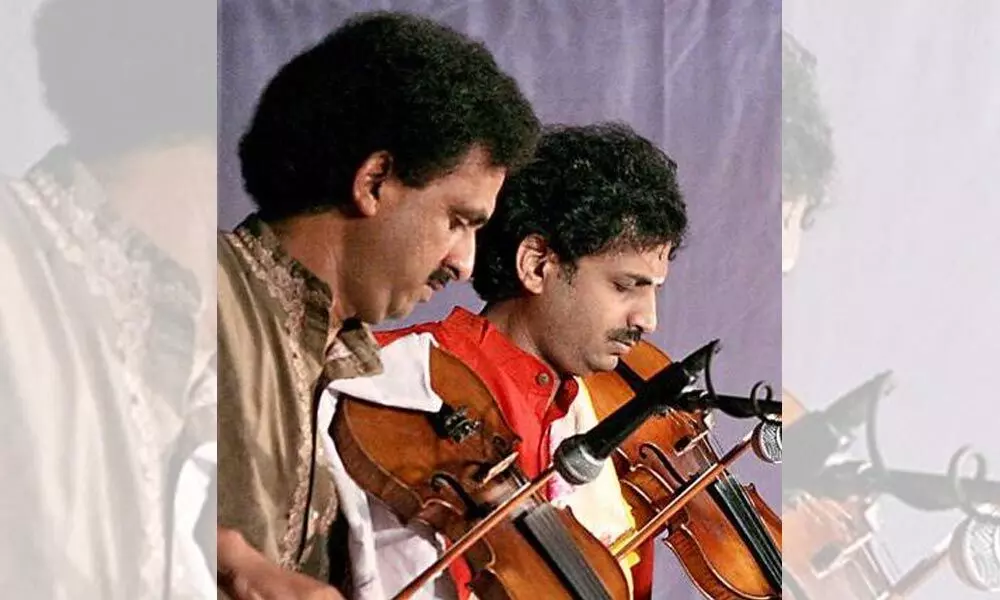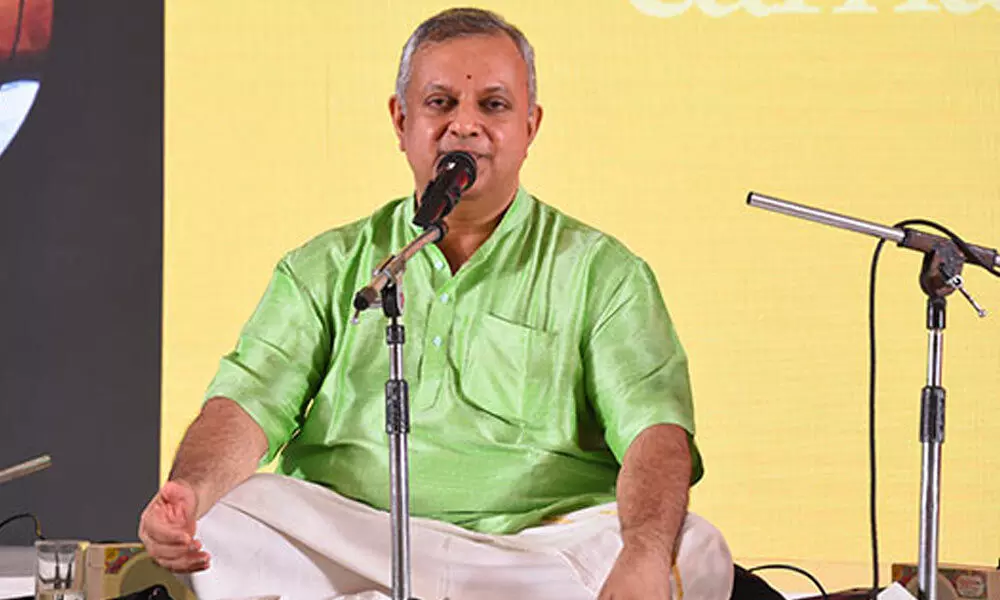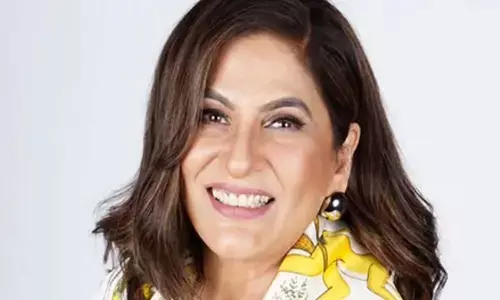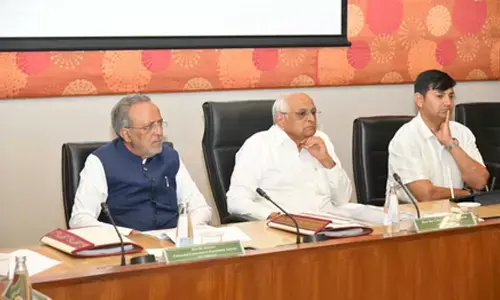Enriching and Inspiring
 Dr. Anasuya Kulkarni with Angkhlung
Dr. Anasuya Kulkarni with AngkhlungLec Dems by master musicians conducted as part of Karnataka Ganakala Parishat Golden Jubilee Celebrations enabled interactions and serious interest in the audiences as most of them were musicians, connoisseurs and pure rasikas
The recently concluded Golden Jubilee Celebrations of Karnataka Ganakala Parishatwas one of a kind event, which was held for 16 consecutive days where musicians, popular nationally and internationally gathered to make it a shining example of 'a world unified by music.' In all there were 50 music concerts, 20 lecture demonstrations during the celebrations.
It is said "the more we remain open to listening, the more we can hear the larger, greater expression" –Lec-Dems help the audience to hear the larger greater expression music can create.
The exposition, exploration, interpretation, scholarly analysis of music and various aspects of musicology made by the erudite musicians in their Lecture demonstration sessions that were part of the programme, made them very inspiring and fascinating, educative and interesting.
'Violin VaadyaVaibhava'
When two violin virtuosos like Mysore Nagaraj and Dr. Manjunath brothers get ready to pour out their knowledge through their Lec-Dem, the result can be mesmerising and mind blowing. With superlative sangeetaJnanam, fingering technique and bowing skills, they are known to hold the audiences spell bound worldwide.
Mysore Brothers' lecture demonstration was educative and was full of creative energy, and thorough knowledge. Dr. Manjunath went into finer details of the subject - 'Violin', explaining the history, the making of violin, its special features and merit of the instrument. The origin and development of violin, how the shape was predominantly influenced by Baroque architecture style, the qualities of the instrument and how it is so well adapted, its entry into Indian music, and growing as a solo instrument, slowly occupying the single most important position in literally every single segment of Carnatic music. The Brothers explained and demonstrated the different styles of violin playing, the execution of complex gamakas and other vinyasas on the violin.
The complementary aspects of vocal and instrumental music When music beautifully integrates all the elements of creation, it becomes a multi- sensory experience -earthy, fiery, flowing, spatial... making the listener enjoy the musical layers distinctly to reach a state of natural bliss. Prince Rama Varma is known for his exceptional vocal and instrumental musical exposition integrating the best elements of music to take the listener to a higher realm.
Prince Rama Varma's brilliant teaching skills backed by deep knowledge of the subject, made his Lec-Dem very absorbing. He stressed on the point that it is ideal for a vocalist to know an instrument and for an instrumentalist to know singing. The interdependence of both he showed through very fine illustrations. He explained the important nuances between Gayaki style and tantrakari style and why a musician should know where to cut the sahityam and swaram properly to not mangle the very meaning of the song. He demonstrated by singing a pancharatna song -"endaromahaanubhaavulu' to the delight of the audience. He made his Lec-dem very interesting with unrestrained spontaneity and by bringing in eclectic musical examples from the renditions of many renowned musicians and typical to his style brought in a short quiz interlude that heartened the young students of music in the audience.
Pancha Nada Swara, Raga, Vaadya, Rangavaibhava' (A rare and unique instrument 'Anghklung ')
A Hindustani vocalistDrAnasuyaKulakarni engaged herself in propagating Indian music in all different countries through performances, demonstrations and teaching music in Universities and Institutions. While in Indonesia, she came across Anghklung, a bamboo rattle instrument played by a group of people each holding a note or two and rattled on the direction of a conductor. This sound enchanted her and she adopted this group playing instrument by making few innovations in the stand and playing technique to a "solo" Indian music playing instrument and has named the new device as "Ankrang" She mastered the skill of playing Indian Karnatic classical music on the Ankrang and has enthralled audiences the world over with her resplendent music. For introducing this instrument to the Indian music, her name was entered into the "Limca Book of Records of 2008 edition.
Dr. AnasuyaKulakarni and Vid.Ramesh explained about how the concept of Pancha (5), plays a very significant role in our life. Our body is made up of 5 elements-Agni(fire), Vaayu(air),Akash(cavity), Prithvi(earth) all our internal organs, and Jala (Water), This PanchaTatva also plays a very significant role in Nature, Philosophy, Astrology & also in music. Her concept was taken to create a musical theme with 5 Angklungs, 5 String Instruments,5 Indian drums and 5 Foreign drums, 5 Spiritual instruments, with 5 Swara 5 Raagas, 5 Nadas, 5 Nada Mukhtayas, In addition, Music of 5 Countries and 5 states of India, Prayer to 5 faced Ganesha and PancharatnaKrithi. The artists were dressed in 5 different colours. It was a unique lec-dem.
'Kanjari Vaadya Vaishishtya'
Vid. G Guru Prasanna is a highly talented musician, who has made a mark as one of the finest in the art of playing khanjira, a single-handed frame drum. He is considered as highly skilled and sought after khanjira artistes' of India. He is blessed to learn from the 'Harishankar School of Khanjira', an unparalleled institution.His prowess includes deft handling of the instrument mixed with powerful strokes and razor-sharp responses, which are the trademark of the school he comes from.
Vid. AmithNadig comes from a family of musicians and has been widely acclaimed as a child prodigy of Karnataka. He effortlessly adapts his playing to perform with musicians from different genres of music including Carnatic, Hindustani, Jazz, Fusion etc. which makes him a very sought after flautist in India today.
Vidwan G. Guruprasanna began his lec-dem by rightly offering prayers to "NaadaDevate" as Khanjira being a Naadavaadya. He explained in detail the ancient references to the instrument, the different names in which it was being referred and also the structure of the instrument. He demonstrated how to handle complex structures and double strokes in the instrument. For the demonstration, he aptly chose to perform for a 50 letter taala to the occasion. He along with the flutist VidwanAmitNadig, played a Pallavi structure and had musical conversations throughout. Layavinyasa was played in 3 different forms of 50 letters including "SampoornaKhanda", 10 letters per beat. Since this was a complex cycle, taala was shown by VidwanAvinash Krishna.
History and Development of Ghatam Vid. ThetakudiHariharaVinayakram also knownas VikkuVinayakram, is a Grammy Award–winning (Planet Drum) Indian percussionist and is credited with popularising the ghatam.
Vid.SukanyaRamgopal - The first female Ghatam playerSuknayaRamgopalexcels both as a soloist and an accompanist. She has developed a distinctive style of playing, 'GhataTharang' – playing of 6/7 ghatams of different Shrutis, and 'SthreeThaalTharang' – an all women's instrumental ensemble.
GhatamGiridharUdupa is a percussionist and a leading exponent of the ghatam. He is one of the members of Layatharanga, a team of Indian classical musicians who have embarked on the task of blending different forms of classical, folk and world music.
The Lec-demby the great trio was on the many aspects of Ghatam – right from making of the Ghatam- how earlier the mixing of materials - like clay, iron fillings, copper, silver, gold and aluminum particles with which Ghatams are made was done using hands and legs- that mixing machines now have made the process easier. And about how Ghatams were earlier burnt in open fire due to which out of 100 only 60 used to be in playable condition and the rest used to develop cracks or holes. Udupa told that through crowd funding 8 lakh rupees were collected with which they had procured an electric kiln and gifted it to the one and the only family near Madurai which is making Ghatams for the last four generations. Now more than 80 to 85 Ghatams get ready for playing out of 100 – a significant improvement. They demonstrated the way Ghatam artistes align themselves to various rhythm techniques, rhythm percussions and to different genres like jazz, Irish Music etc and as to how they bring in those elements into Carnatic music.

















